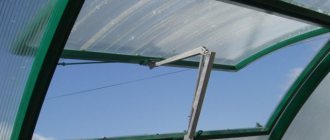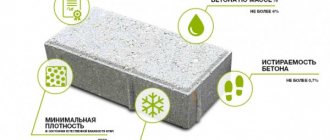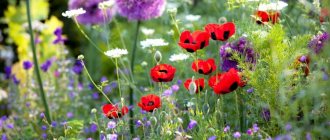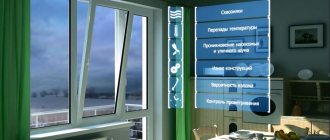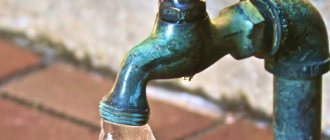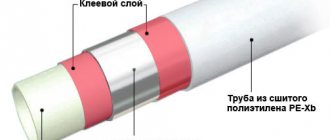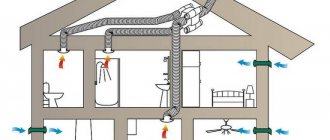- Irrigation system at the dacha: a variety of options for irrigating plants
- Types of irrigation systems for gardens and cottages
- Subsurface irrigation system for greenhouses
- Rain garden watering system: features of the option
- Operating principle and distinctive features of drip irrigation
- Irrigation system at the dacha depending on water supply
- Selection of pipe material for irrigation in the country, product characteristics
- How to do watering at the dacha with your own hands: main points
- Installation of watering and irrigation systems for a summer residence
- Video: how to make drip irrigation at the dacha
Irrigation system at the dacha: a variety of options for irrigating plants
To make life easier for gardeners and gardeners, design engineers and craftsmen are constantly inventing a variety of irrigation systems. There are many ways to water plants, from using a regular watering can to automatic watering systems. Which irrigation system is preferable to use at the dacha, how to water the site, what methods of installing irrigation systems are most popular - all this information is described in detail in this article.
Automatic watering system: how to make automatic watering at your dacha (read more)
An irrigation system is an indispensable attribute of any private home or summer cottage.
What types of sprinkler devices are there?
High-quality and efficient soil irrigation systems based on the sprinkling principle require the selection of special installations, which come in three types: statistical and pulse or rotary, divided according to the method of operation.
When making a selection, such indicators as the intensity of spraying and the area of the treated area are taken into account; different devices guarantee the formation of different water flows, are easily adjusted and allow automated use with the adjustment of functional parameters.
Types of irrigation systems for gardens and cottages
Existing irrigation systems can be divided into four categories, each of which has characteristic advantages and disadvantages:
- surface watering;
- drip irrigation;
- subsurface irrigation;
- sprinkling.
Each type of green space and garden crops needs different methods of watering.
On a note! At your summer cottage, you can organize several irrigation systems, since each crop needs a certain moisture regime.
Surface irrigation is a less expensive irrigation option. Water is supplied to the plant through dug grooves directly from a hose, which can be connected to a centralized water supply system or to a barrel for irrigation in the country. You can buy a container of any capacity. The irrigation system is located on the surface of the ground, so installing it yourself is not difficult. This method deprives the roots of some oxygen, which can be detrimental to plants. Therefore, constant use of surface watering is not recommended.
A popular method of watering is sprinkling on the site
To organize this method of irrigation, specialized sprinkler systems are used that provide ground watering due to the principle of simulating rain, absorbing the required amount of moisture for normal growth of green cover.
Uniform and economical distribution of water guarantees the formation of an optimal microclimate in the allocated area, while ensuring full coverage of the area by several specially configured installations.
Subsurface irrigation system for greenhouses
Subsurface watering is carried out using an irrigation system, which is located under the soil layer at a depth of 30 cm. Mini-holes are made throughout the entire area of the pipes, through which water flows to the roots of the plants. This system is most rational for green spaces such as trees, fruit bushes, and grapes. It is also successfully used in greenhouses where regular digging is not carried out. However, it can also be used in a summer cottage, planting annual plants depending on the location of the system.
A surface irrigation system is commonly used in greenhouses.
This option promotes good oxygen access to the roots and does not require constant loosening of the soil. Underground irrigation is organized in areas with water scarcity, since this option reduces its consumption by half compared to the surface option. Watering can be carried out from a watering tank at the dacha.
On a note! To minimize the likelihood of clogging the holes in the pipeline, a filter should be installed at the beginning of the irrigation pipe.
The system can be laid vertically at the time of planting the perennial plant. The planting hole is made 30 cm deeper and 20-25 cm wider than required for rooting the crop. The bottom is covered with a layer of crushed stone 20 cm high. The pipe is inserted vertically, plunging 7-10 cm into the thickness of the crushed stone. The length of the segment is selected taking into account the protrusion of part of the product above the ground surface by 10-12 cm. The pillow is covered with soil 10-15 cm thick. Open end closed with a plug.
Underground irrigation allows you to save water and at the same time evenly moisturize the soil from the inside.
Watering is carried out from a watering can or hose directly into the pipe. Water goes directly to the plant's root system, eliminating the need to moisten the top layer of soil. The irrigation rate depends on the climate zone of the area. For many plants of the same type, automated watering can be organized.
Rain garden watering system: features of the option
When organizing a sprinkler system, water in the form of drops gradually moistens the soil near the plant at a certain angle. This process is carried out using special sprinklers and sprinklers, which are installed in certain places of the summer cottage at a certain distance from each other. For areas completely covered with vegetation, such as lawns and flower beds, rotating sprinklers are provided that evenly moisten the soil around them.
Drip irrigation: watering for a dacha at no cost (read more)
Sprinkling promotes gradual, high-quality and deep moistening of the soil, due to which its structure is not damaged. With this method, the above-ground parts of the plant are saturated with moisture, which contributes to increased productivity. This is especially true for strawberry plantations. If the sprinkler nozzles are located under the tree crowns, they will simultaneously water and wash away dust and insects from the leaves. In addition, if lawn grass is planted under the trees, this is the most rational way to moisten it.
Sprinkler irrigation is often used for lawns and long beds.
When setting up the device, you should focus on maintaining a balance between the intensity of rain and the ability of the soil to absorb water. Moisture must have time to be absorbed into the soil to prevent the formation of puddles and dirt. This can lead to the surface of the earth floating, which, after drying, will become covered with a crust, which will prevent the access of oxygen to the roots of plants.
One of the disadvantages is that water is sprayed unevenly during strong gusts of wind and insufficient pressure in the main system. Also, water can get not only into the beds, but also onto the paths.
The sprinkler system can be stationary or portable. In the first option, irrigation pipes are laid on top of the soil or mounted in the ground to a depth of 30-40 cm. In places where sprayers are installed, vertical sections of pipelines are brought to the required height. Sprinkler nozzles are attached to their ends.
The sprinkler system can be of above-ground or underground type and consist of several sprinklers that uniformly moisten the area.
When organizing portable irrigation, hoses are used for watering in the country. The best products are made from thermoplastic elastomer or PVC. Sprayers are installed at the ends of the hose. The products are placed in the required place for watering garden crops. For this system, it is convenient to organize automatic watering, which will be programmed to turn on at the most suitable time for watering - in the evening. By morning, the water will be absorbed, and during the day you can loosen the soil to ensure oxygen access to the roots of the plant.
Need for watering
When purchasing a lawn, you need to remember that it needs moisture, and surface watering will not be enough. For it to be considered correct and of high quality, it is necessary to ensure that water penetrates into the soil at a distance of at least 5-6 cm, which will help maintain colorful greenery for the lawn.
Not everyone has the opportunity to pay a lot of attention to their lawn. This is where automatic lawn watering comes to the rescue, caring for the lush greenery of the lawn on its own. You only need to carefully configure its automation according to the instructions.
Operating principle and distinctive features of drip irrigation
Do-it-yourself drip irrigation at the dacha is the most economical and rational irrigation option. The principle of operation of the system is based on the flow of water in small portions directly to the roots of the plant through a drip tape connected to an irrigation pipe. This option is possible when supplying water to the central water supply for irrigation in the country. If it is served by the clock, then moisturizing will occur in the same way.
Such irrigation can be carried out from a storage tank for irrigation at the dacha if there is no water in the main pipeline. This option will ensure round-the-clock irrigation of the soil.
Drip irrigation is one of the popular methods of irrigating flower beds and greenhouses.
This method of watering does not interfere with air access to the roots of the plant and does not contribute to the deterioration of the soil structure. In this case, you can avoid drying out or flooding the soil and refuse to regularly loosen the soil. The main disadvantage of such an irrigation system is the high probability of pipe clogging, which occurs as a result of small debris and soil particles entering its cavity. Therefore, the system needs periodic cleaning.
This type of watering can be done using drip tape, a rigid hose with small holes, or small-diameter plastic pipes. The elements are laid along the bed with plants and connected to a common pipe. To organize watering of several rows, a splitter is mounted, which is located at the beginning of the bed. It promotes uniform distribution of tape segments. The tape is laid in a spiral around the tree trunk. Plastic pipes are usually installed along permanent beds. Holes are first made in them using a hot awl.
Equipment selection
You need to find and choose the right equipment; as a rule, the size of the equipment varies depending on the size of the site itself.
- plastic pipes;
- connectors;
- sprinklers;
- drip hoses;
- automatic valves;
- pump;
- water tank;
- rain or soil moisture sensors;
- programmable controller.
Irrigation system at the dacha depending on water supply
Water can be supplied to the irrigation system in one of the following ways:
- automatic;
- semi-automatic;
- mechanical.
Each method of supplying water to the root system of a plant has both its advantages and disadvantages.
The first option is carried out depending on the wishes of the owner and is set by a special program. In this case, the start time for watering is set or humidification sensors are installed, relative to which water will be supplied. You can buy such a system ready-made or organize automatic irrigation yourself.
When installing an automatic system, a self-priming pump must be used for watering a vegetable garden, home garden, or cottage, which pumps water from a container. When choosing a unit, you should pay attention to the frequency of engine adjustment and the possibility of a soft start. It is connected to a switch-on timer that controls the operation of the pumping unit.
When organizing automatic watering at your dacha with your own hands, you can purchase a socket with a timer, which involves daily or weekly irrigation. This system is most often used for sprinkling. However, it can be organized for other options. Wells, reservoirs located near the land plot, or a centralized water supply system can be used as water storage facilities.
The automatic watering system is convenient because it irrigates at a specified time and does not require much human effort.
Semi-automatic irrigation involves manually supplying water to the common pipe. Then the system independently distributes the liquid through the pipes, regulating its flow and pressure.
On a note! At any time, by changing the settings, you can switch from semi-automatic to automatic mode without turning off the water supply tap.
With mechanical watering, the moistening of the beds is controlled by a person who manually opens the watering tap at the dacha, selecting the required pressure.
conclusions
Proper organization of watering systems for your garden will provide you with abundant flowering and a high harvest. An optimal, functional and economical network must be carefully designed to ensure constant soil moisture. In combination with it, it is important to maintain the soil, preventing the crust from drying out, which can lead to water not passing to the depth required for the roots.
Ensure constant monitoring of pipelines in order to troubleshoot problems and clear contaminants in a timely manner. Photos of various watering systems in special brochures, magazines, and on Internet pages will help you create not only a practical, but also a beautifully designed irrigation system that will fit perfectly into the design of your site.
Selection of pipe material for irrigation in the country, product characteristics
Before organizing irrigation at your dacha, you should decide on the material of the pipelines for the selected irrigation system. Metal products are characterized by strength, reliability, durability and affordable cost. Among the negative factors are the high cost of shaped connections and shut-off valves, the susceptibility of products to corrosion, and the complexity of installation, which requires special skills and abilities.
The quality of pipes and materials is the key to long-term service of the irrigation system.
Plastic products are more modern, practical and inexpensive. The walls of the pipes are extremely smooth, so that deposits will not accumulate inside the pipelines, which eliminates a decrease in the throughput of the product. The material is characterized by strength and durability.
HDPE pipes for irrigation in the countryside do not respond to temperature fluctuations or exposure to aggressive environments, and can be used for above-ground and underground installation. The connection of PVC system elements is carried out using glue, mastic and structural fittings - this can be done independently, without having special skills.
Among the most popular manufacturers of polyethylene pipes are the companies Rehau, Wavin and Ostendorf, which produce high-quality products with high technical and operational characteristics. The price of pipes for irrigation at the dacha is 50-90 rubles/m.
By choosing pipes produced by well-known brands, you can be confident in the quality and durability of the products.
The most durable and flexible are polyethylene pipes, which do not burst when water freezes. The most optimal option is considered to be a product diameter of 20-40 mm. The system elements are connected using the soldering method. Polypropylene pipes are a more economical option. They have increased strength and durability. Individual sections are connected by soldering joints or fastening with couplings. You can buy pipes from well-known manufacturers Rehau, Aquatherm, Banninger, Wefatherm, Ekoplastik, Valtek, Pilsa, Pro Aqua, Santrade for 30-60 rubles/m.
How to do watering at the dacha with your own hands: main points
Creating an irrigation system begins with planning. At the first stage, you should draw a diagram of the site with all the beds and plants that need watering. Next, all options for water supply are provided, which can be carried out from a centralized water pipeline or from an irrigation tank at the dacha. You can buy a tank of any capacity in a specialized store. It is installed at a height of two meters and has a lid on top to prevent debris from accumulating in the water.
If there is a well or well on the site, you can organize an alternative water supply system. In this case, you should decide on a pump for irrigation at the dacha, which is selected taking into account the required flow rate.
Layout of the automatic irrigation system on the site.
Note! The irrigation system at the dacha made of plastic pipes should be located in such a way that the entire territory is covered. Otherwise, the missed area will have to be watered manually.
The drawing should indicate pipelines and shut-off valves. Here it is necessary to note all connections and interweavings of pipes. Based on this, it is necessary to calculate the total number of plugs, tees, splitters, start connectors (in the case of organizing drip irrigation), sprinklers (when installing a sprinkler system). Subsequently, a list of necessary materials and equipment is compiled for arranging a water supply system at the dacha for irrigation with your own hands.
It is better to choose plastic pipes for the main pipeline, since they can supply fertilizer or fertilizer dissolved in water. If a subsoil system is being implemented, preference is given to thick-walled products. When laying above ground, an opaque material is used, which will help to avoid water blooms inside the pipelines.
Since pipes for an irrigation system are usually installed for more than one season, you should carefully select products and pay attention to quality.
On a note! You should not skimp on materials for your irrigation system. Since it is installed for many years, it is worth choosing high-quality, certified products.
In the case of organizing an automatic irrigation system, it is necessary to purchase an electric controller. It is powered by self-contained batteries. It is also recommended to stock up on filters that will protect the system from clogging. This is especially important for drip irrigation.
Construction principles
The concept of automatic watering is briefly as follows. There is a water source, from which a main pipeline is routed across the site to the irrigation zones. Next, using tees, crosses, small-diameter pipes and water supply devices, an irrigation system is created. For normal operation of water outlet units, filters are required; they are installed on the main water supply. That's all. Everything else is specific. There may even be a pump or a control system, or you can do without them
Do-it-yourself automatic watering system is a real task
Read here how to organize water supply to your home from a well or borehole.
How to control
Irrigation can be controlled by a controller (automation unit) or a person by turning the tap. If a controller is installed, the system is almost completely automated: it turns the water supply on and off at a given time. There are devices with a very high degree of automation - they monitor the weather, soil moisture and adjust the operation of the equipment in accordance with this data. In the simplest version, automatic irrigation supplies water at a specified time and turns it off after a certain period of time (set in the settings).
If there is no irrigation controller, a person needs to open the water supply and stop it. But that’s all that’s required of you; the irrigation system will do the rest.
Water consumption and irrigation intensity
Since the flow of water through distribution points is generally normalized, it is possible to determine with fairly high accuracy how long watering should last so that there is not too much water and not too little. If all watered plants require the same amount of water, no difficulties arise, but this does not always happen. This is the case with a lawn; sometimes there are extensive plantings of identical plantings in a vegetable garden or garden. But a more common situation occurs when some plants are more moisture-loving, others less so. There are several ways to solve this problem:
- Install drippers or sprinklers with adjustable water flow. With their help, for each area or plant, set the required amount of moisture in one watering.
- Use multi-zone controllers. They can independently control multiple watering zones. This is convenient in the garden, garden or greenhouse, where there are extensive plantings of plants that require different moisture levels.
Sometimes it is more profitable to make two autonomous irrigation systems
- Make several independent systems. Sometimes this is more profitable than stretching a long pipeline from one section to another or purchasing complex controls.
That’s why you can do automatic watering yourself: you have a lot of opportunities to achieve the desired result.
Where to get water from
The source of water for an automatic irrigation system can be a water supply system, a container with pumped water, a well, a well, a river, or a lake. In all cases, filters are installed on the main pipeline. It's just that different sources require different equipment. If you pump water from an open source (river, lake), be sure to install a coarse filter first, then a fine filter. In all others (except for drinking water supply) only equipment for fine cleaning is installed.
Watering the area with your own hands can be done from any water source.
If we are talking about automatic watering of a garden or greenhouse, then it is definitely better to first pump the water into a container where it will heat up, and then distribute it throughout the area. For dachas and garden plots there are a number of systems that work almost by gravity. They need minimal pressure, which is created by raising the container to a height of about 1-2 meters. There are systems that can work if the container is raised 10-40 cm above the ground.
With such an organization - with a water container - you can choose any pump for an automatic irrigation system. If only he could periodically pump water into the tank. The water level in the container is most often controlled by a float mechanism (like the one in a toilet tank). In this case, do not forget to provide for an emergency overflow and take it to some source, otherwise your area may turn into a swamp.
If a water supply is used as a source - centralized or not, and drip irrigation is selected, a reducer is needed to reduce and stabilize the pressure in the system, since most of this equipment can operate at a pressure of no higher than 2 atm.
Installation of watering and irrigation systems for a summer residence
The laying of plastic pipes for irrigation in the country can be underground or above ground. The second option involves the location of all elements of the system on the surface of the earth. Installation of such a device is quite quick. If leaks occur, they are easy to detect and repair. However, the surface location has its drawback: the risk of pipe damage increases. In addition, such a gasket can make it easy for attackers.
A more preferable option is to install a deep-seated garden watering system with your own hands from polypropylene pipes or polyethylene products. According to the planned plan, a trench 30-70 cm deep is made with a slight slope towards the lowest point of the site. This is necessary to ensure that water is drained from the pipeline at the end of the season. Pipes can also be laid without a slope. In this case, at the end of the season they are purged using a compressor.
It is best to entrust the laying of pipes for the irrigation system and installation to a specialist.
At the next stage, water is distributed to the dacha by laying pipes in a trench. All branches should be inserted into the main pipeline. For this purpose, crosses or tees are used. Each outlet must be equipped with a valve to control the water supply to each section. For outlets, you can use pipes of smaller diameter or flexible hoses for watering in the country. Drippers or sprinklers are attached to the ends of the pipes.
The assembled system is connected to the main pipeline, then it is automated. After completion of the work, the system is tested. To do this, it is filled with water. If leaks are found, they must be repaired immediately. After the test, the trench is buried.
An irrigation system assembled with your own hands from high-quality material can last for many years, relieving site owners from routine and monotonous work. The main thing is to study the features of the chosen irrigation option, purchase the material, after which you can safely get to work.
Automatic watering installation
Automatic lawn watering must be installed before you begin planting your lawn. The process is carried out in several stages:
- The top layer of soil is removed (about 40 cm)
- Pipe laying in progress
If the lawn has already been planted, its turf layer must be carefully cut off and, after installing an irrigation system, put in place.
Arrangement of irrigation near an alpine hill Source mirsada.kiev.ua
See also: Catalog of companies that specialize in the installation of engineering systems.
It is recommended to group the growing plants before starting to install the automatic watering system. They are planted in groups, taking into account the amount of moisture they need. The site is zoned and water sprinklers with the power required for a particular site are installed.
When the system is installed in an area where bushes or trees grow, it is recommended to install sprinklers with a counter-irrigation stream.
Sometimes, for quality lawn watering, equipment needs to be additionally equipped. For example, if the groundwater in the region is polluted or its technical characteristics do not allow use without preliminary treatment, additional filters will need to be installed.
Even before the onset of frost, it is imperative to drain the remaining water in the system. This will prevent pipes from bursting when frost sets in.
